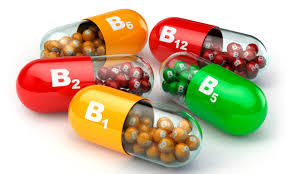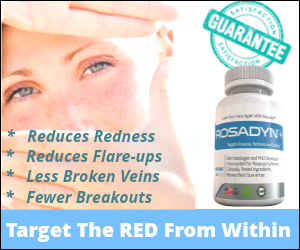The purpose of this article is to highlight the fact that B Vitamins and B Vitamin Complexes can contribute to acne rosacea, facial redness, flushing and even trigger acne in non-rosacea sufferers. B Vitamins are one of the top selling vitamins due to their many actions on energy production, food conversion and “stress relief”. The primary problem is that most of these B Vitamins are incorporated into “B Complex Supplements” and/or “Multi-Vitamins” at mega doses well above the recommended daily allowance (RDA). At mega doses many rosacea sufferers and non-rosacea sufferers experience skin disturbances. It’s a good idea to stop any B vitamins for at least two weeks to determine if they cause skin breakouts. We will review the literature and several clinical case studies regarding this generally unknown phenomenon.[/message_box]
B Vitamins and B Vitamin Complexes
B vitamins are a class of water-soluble vitamins that play important roles in cell metabolism, cellular health, cell renewal, energy production and stress relief. Though these vitamins share similar names, research shows that they are chemically distinct vitamins that often coexist in the same foods. In general, dietary supplements containing all eight are referred to as a vitamin B complex. Individual B vitamin supplements are referred to by the specific name of each vitamin (e.g. B1, B2, B3 etc.).
Each B vitamin is either a cofactor (generally a coenzyme) for key metabolic processes or is a precursor needed to make one. They are necessary for dozens of bodily functions and human health.
B Vitamins:
- B1 (thiamine)
- B2 (riboflavin)
- B3 (niacin or nicotinic acid)
- B5 (pantothenic acid)
- B6 (pyridoxal hydrochloride)
- B7 (biotin)
- B9 (folic acid)
- B12 (cyanocobalamin)
B Vitamin Mega Doses
At normal levels, these are effective, safe vitamins; however many B complex vitamins, energy drinks and multivitamins contain mega doses of these B Vitamins to boost energy production, increase mental awareness and reduce stress (they aid the adrenal glands by reducing the release of stress hormones and stress neurotransmitters).
B Vitamin Complex Mega Dose Example (one popular brand):
- B1 (thiamine) — 100 mgs (6,667% above the RDA)
- B2 (riboflavin) — 100 mgs (5,882% above the RDA)
- B3 (niacin or nicotinic acid) — 100 mgs (500% above the RDA)
- B5 (pantothenic acid) — 100 mgs (1,000% above the RDA)
- B6 (pyridoxal hydrochloride) — 100 mgs (5,000% above the RDA)
- B7 (biotin) — 1,000 mcg (333% obove the RDA)
- B9 (folic acid) — 800 mcgs (200% above RDA)
- B12 (cyanocobalamin) — 100mcgs (1,667% above the RDA)
These extremely high doses are now common place in B Complex Vitamins, Multi-Vitamins and Energy Drinks. These levels are much too high .
B Vitamin Mega Doses and Skin Breakouts
Clinical case studies by physicians have demonstrated that mega doses of particular B vitamins can cause acne rosacea, regular acne, oily skin, flushing and skin redness. If you have any question regarding whether your vitamins, energy drinks, energy bars or any other food stuff with mega doses of B Vitamins is making your rosacea worse — or actually mimicking rosacea — physicians recommend that you stop intake of any B vitamin for at least two to three weeks. This should be enough time to flush your system and help you determine if B Vitamins are adversely affecting your skin health.
Clinical Case Study: Mega Doses of Vitamin B6
Pyridoxine induced rosacea-like dermatitis.
Abstract
Rosacea is a common chronic inflammatory cutaneous disease of unknown etiology, characterized by remissions and exacerbations, presenting with centrofacial erythema and telangiectasias. It affects mainly adults around the age of 30 years and classically predominates in females. The pathophysiology of rosacea has not yet been fully understood. Risk factors are positive family history, very light skin phototype, sun exposure and consumption of spicy food or alcohol. Recently, there has been some evidence that some drugs or vitamins could be potential factors that can aggravate rosacea or induce rosacea-like symptoms. In this context, we present a 53-year-old female developing rosacea-like dermatitis due to a fixed combination of isoniazid and pyridoxine, which she was receiving along with rifampicin for the treatment of pulmonary tuberculosis.
- PMID:26058251
Clinical Case Study: Mega Doses of Vitamin B6 and B12
Acneiform eruption due to “megadose” vitamins B6 and B12.
Abstract
Medications and other exogenous factors are known to be capable of exacerbating acne or precipitating acneiform eruptions. This case illustrates an eruption resembling acne rosacea that was temporally associated with daily ingestion of high-dose B vitamin supplement. The eruption failed to respond to the usual treatment regimens for rosacea, but promptly improved when use of the vitamin supplement was discontinued.
- PMID:1834437
Rosacea fulminans triggered by high-dose vitamins B6 and B12.
Abstract
Rosacea fulminans is a rare variant of rosacea conglobata that occurs almost exclusively in women well past adolescence. The aetiology is unknown, although immunological, hormonal, and vascular factors have been suggested. We report the case of a 17-year-old girl with rosacea fulminans that was temporally associated with daily ingestion of high-dose vitamin B supplements. The onset was sudden and cosmetically disabling. The eruption improved when the vitamin supplement was discontinued and a therapeutic regimen including isotretinoin and methylprednisolone was introduced. It seems appropriate to consider the possibility of such a vitamin B-triggered condition in cases of subjects presenting new or exacerbating facial eruptions.
- PMID:11763399
Niacin trigger flushing and facial redness in rosacea sufferers and non-rosacea sufferers.
Niacin is a potent dilator and should never be used by rosacea sufferers at any dose. Even though it is an effective cholesterol lowering agent, there are better options through generic prescriptions that do not cause flushing. Dozens of studies have demonstrated the potent flushing (and itching) associated with as little as 10 mgs and this reaction often lasts several hours. These flares can cause rosacea to progress.
There are two options that rosacea sufferers can take — referred to as “flush-free” niacin:
- Niacinamide
- inositol hexaniacinate
Feedback
Please help other rosacea sufferers by detailing your experience with mega dose vitamin b complexes and how you treated any adverse reactions.

